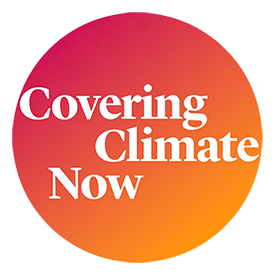 This column is part of Covering Climate Now, a global journalism collaboration cofounded by Columbia Journalism Review and The Nation to strengthen coverage of the climate story.
This column is part of Covering Climate Now, a global journalism collaboration cofounded by Columbia Journalism Review and The Nation to strengthen coverage of the climate story.
It’s been a heavy week for those of us who want to preserve life on earth. Somehow, the latest, greatest hope for a livable future is in the hands of one man—a senator, not even a king! Given how few Americans voted for him, it’s absurd that Joe Manchin has so much national influence. But when you factor in the scale of US power and its historic and current responsibility for the climate crisis, it’s downright grotesque.
When Senator Ed Markey joined climate activists outside of the Capitol on October 7, he said, “There’s no middle ground between a livable and an unlivable world.”
But there is a world in between—and we’re in it now. It’s a world where everything feels tenuous, like if you touch anything, it might all crumble. It’s one where you feel uneasy making plans months in advance, because you can’t picture the future. Today, coming up with a 10-year plan feels ridiculous—like building a house on quicksand.
As we careen from crisis to crisis, it’s hard not to wonder whether the world is ending. But, for the only species with a record, for better or worse, of intentionally changing the planet, that’s a cop-out. The real question isn’t about what the world is doing, it’s about what we’re doing. It’s not whether the world is ending or beginning. It’s whether we’re creating or destroying it. And the answer is, of course, both.
The climate crisis is a crisis of many things: science, economics, politics, immigration. As the author Amitav Ghosh said, “the climate crisis is also a crisis of culture, and thus of the imagination.” To be clear, that doesn’t mean innovation or invention—we’ve got loads of ideas for solar panels and microgrids. While we have all of these pieces, we don’t have a picture of how they come together to build a new world. For too long, the climate fight has been limited to scientists and policy experts. While we need those skills, we also need so much more. When I survey the field, it’s clear that what we desperately need is more artists.
We talk a lot about building a “livable future,” but what does that really mean? Not much for those of us barely surviving today. Furthermore, I don’t want a future that’s merely livable. I want a beautiful world. I’m sick of nightmares, and I’m ready to dream again.
I’d like to introduce to everyone the concept of world-building. At its core, world-building is what it sounds like: the process of creating an imaginary world for a work of fiction. It’s the practice of taking the ideas in your head, the sensations from your imagination, and allowing people to see what you see, feel what you feel. It’s as much about creating new things as it is about destroying old structures and assumptions. It’s an art, not a science.
World-building is often thought to be the domain of science fiction, but any work of fiction, or even nonfiction, requires it. You have to build the world as your character sees it, because as every novelist knows, world-building is more about the characters than about the environment. And so it is in life: None of us experiences the world the same way, so we live in our own little versions of it.
We need to apply world-building to the planet we live on. While artists might be the most accomplished at this, they can’t do it alone this time. We’re all going to have to push our imaginations. Here’s one way to start: Close your eyes and think of the world as you see it. Remember that world-building begins with the main character. (That’s you!) So ask yourself: Who are you, and what do you stand for? And now, what do the people around you stand for?
Picture your surroundings. Observe everything that’s beautiful and everything that’s ugly, scary, uncertain: the storms, the fires, the injustices, the screaming, the gnashing of teeth. As you consider your surroundings—including the laws of society and mores of culture—take note of how you feel in them, how you interact with them. Think about what you can change and what you can’t. Open your eyes. Breathe.
Now, close your eyes and imagine the world you want to live in. You’re starting with the same main character. (Still you!) But maybe the people around you have changed. What do they value in this world? How do they treat each other? What’s important in this new world, and what isn’t? What does power—not just electricity—look like? How does the air feel on your skin? What does it smell like? In my world, there’s laughter and lightness in the air, and it’s not weighed down with those noxious chemicals that make my nose burn. Memorize your version—every detail, every sensation. You’ll need to keep coming back here until you make it real.
When you open your eyes, ask yourself: Is there something from that world I can bring into this one? That’s your job now. If we’re going to make the world over, let’s do it right. Let’s make a masterpiece.


